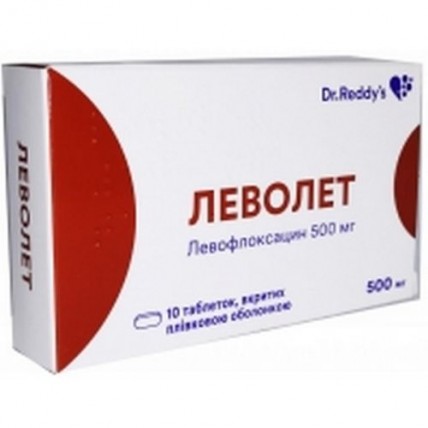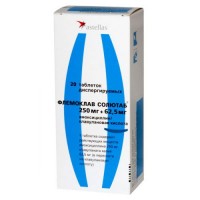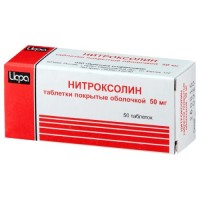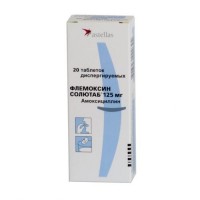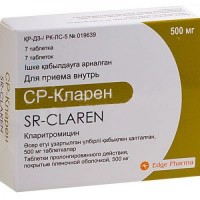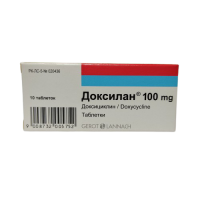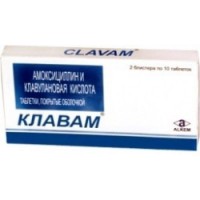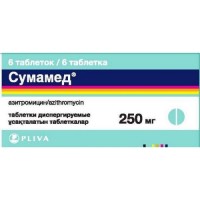Levolet 10s 500 mg coated tablets
- $26.80
The instruction for medical use
of Levolet Torgovoye medicine
Levolet
Mezhdunarodnoye's name the unlicensed
name Levofloxacin Dosage Form
of the Tablet, coated 250 and 500 mg
Structure
One tablet contains
active agent – a levofloksatsin gemigidrat 256.233 mg and 512.466 mg
excipients: cellulose microcrystalline (Avitsel PH 101), cellulose microcrystalline (Avitsel PH 102), starch corn, krospovidon, gipromelloza of 15 cps, silicon dioxide colloidal (Aerosil 200), magnesium stearate,
structure of a cover: opadr white OY 58900, a gipromelloza 5 sr, the titan E 171 dioxide, makrogol/PEG 400, the water purified
the Description
of the Tablet, coated white color of a capsulovidny form with a biconvex surface with an engraving of DRY on one party and 279 on another (for a dosage of 250 mg).
Tablets, coated white color of a capsulovidny form, with a biconvex surface with an engraving of DRY on one party and 280 on another (for a dosage of 500 mg).
Pharmacotherapeutic group
Antimicrobial drugs – derivatives of a hinolon. Ftorkhinolona. Levofloxacin.
ATX J01MA12 code
Pharmacological
Pharmacokinetics Absorption properties. Levofloxacin at intake is quickly and almost completely soaked up, meal influences the speed and completeness of absorption a little, meal influences its absorption a little. The absolute bioavailability at intake is 99–100%.
After single dose, Cmax levofloxacin in blood plasma is reached during 1–2 h and makes (2.8±1.2) mkg/ml for a dosage of 250 mg and (5.2±1.2) mkg/ml for 500 mg. The pharmacokinetics of a levofloksatsin is linear in the range of doses from 50 to 1000 mg. Css of a levofloksatsin in blood plasma at reception of 500 mg of a levofloksatsin 1 or 2 times a day is reached during 48 h.
For the 10th day of reception, levofloxacin of 500 mg of 1 times in day of Cmax of a levofloksatsin in blood plasma makes (5.7±1.4) mkg/ml, and Cmin of a levofloksatsin (concentration before reception of the next dose) in blood plasma made (0.5±0.2) mkg/ml.
For the 10th day of intake of a levofloksatsin of 500 mg 2 times in day of Cmax of a levofloksatsin in plasma make (7.8±1.1) mkg/ml, and Cmin — (3±0.9) mkg/ml.
Distribution. Communication with serum proteins makes 30–40%. After single and repeated dose of 500 mg of a levofloksatsin of Vd averages, about 100 l that indicates good penetration of a levofloksatsin into bodies and body tissues of the person.
Penetration into a mucous membrane of bronchial tubes, liquid of an epithelial vystilka, alveolar macrophages. After single dose in 500 mg of a levofloksatsin of Cmax of a levofloksatsin in a mucous membrane of bronchial tubes and liquid of an epithelial vystilka were reached during 1 - 4 h and made 8.3 mkg/g and 10.8 mkg/ml respectively, with penetration coefficients in a mucous membrane of bronchial tubes and liquid of an epithelial vystilka in comparison with concentration in blood plasma, components 1.1-1.8 and 0.8-3 respectively.
After 5 days of intake of 500 mg of a levofloksatsin the average concentration of a levofloksatsin in 4 h after the last administration of drug in liquid of an epithelial vystilka made 9.94 mkg/ml and in alveolar macrophages — 97.9 mkg/ml.
Penetration into pulmonary fabric. Cmax in pulmonary fabric after intake of 500 mg of a levofloksatsin made about 11.3 mkg/g and was reached in 4–6 h after administration of drug with coefficients of a penetration 2–5 in comparison with concentration in blood plasma.
Penetration into alveolar liquid. After 3 days of reception of 500 mg of a levofloksatsin of 1 times or 2 times in day of Cmax of a levofloksatsin in alveolar liquid made 4 and 6.7 mkg/ml, respectively and were reached in 2–4 h after administration of drug with coefficient of a penetration 1 in comparison with concentration in blood plasma.
Penetration into a bone tissue. Levofloxacin well gets into a cortical and spongy bone tissue, both in proximal, and in distal departments of a femur with penetration coefficient (bone tissue / blood plasma) 0.1-3. Cmax of a levofloksatsin in a spongy bone tissue of proximal department of a femur after reception of 500 mg of drug inside made about 15.1 mkg/g (in 2 h after administration of drug).
Penetration into medullispinal liquid. Levofloxacin badly gets into medullispinal liquid.
Penetration into prostate fabric. After intake of 500 mg of a levofloksatsin of 1 times a day within 3 days, average concentration of a levofloksatsin in fabric of a prostate made 8.7 mkg/g, the average ratio of concentration prostate/blood plasma made 1.84.
Concentration in urine. Average concentration in urine in 8–12 h after intake of a dose of 150, 300 and 600 mg of a levofloksatsin made 44, 91 and 162 mkg/ml respectively.
Metabolism. Levofloxacin is metabolized in insignificant degree (5% of the accepted dose). Its metabolites are demetillevofloksatsin also N-oksidlevofloksatsin which are removed by kidneys. Levofloxacin is stereokhimichesk stable and is not exposed to chiral transformations.
Removal. After intake, levofloxacin is rather slowly removed from blood plasma (T1/2 — 6–8 h). Removal mainly through kidneys (more than 85% of the accepted dose). The general clearance of a levofloksatsin after single dose of 500 mg was (175±29.2) ml/min.
There are no essential differences in pharmacokinetics of a levofloksatsin at it in in introduction and intake that confirms that intake and in/in introduction are interchangeable.
Pharmacokinetics at separate groups of patients. The pharmacokinetics of a levofloksatsin at men and women does not differ.
The pharmacokinetics at patients of advanced age does not differ from that at young patients, except for the distinctions of pharmacokinetics connected with differences in clearance of creatinine.
In a renal failure the pharmacokinetics of a levofloksatsin changes. In process of depression of function of kidneys removal through kidneys and renal clearance decrease, and elimination half-life increases.
Pharmacokinetic indicators in a renal failure after single dose in 500 mg of the drug Tavanik®predstavleny in the table.
Cl of creatinine, ml/min.
& lt,
20 20–49 50–80
Renal clearance, ml/min.
13 26 57 T1/2,
Part 35 27 9
Levolet's Pharmacodynamics - an antibiotic of a broad spectrum of activity from group of ftorkhinolon. Represents left-handed isomer of an ofloksatsin, blocks DNK-girazu (topoisomerase II) and topoisomerase IV, breaks superspiralling and a stitching of ruptures of DNA, inhibits DNA synthesis, causes profound morphological changes in cytoplasm, a cell wall and membranes of microorganisms. Levolet it is active concerning the majority of strains of microorganisms:
- aerobic gram-positive microorganisms: Corynebacterium diphtheriae, Enterococcus faecalis, Listeria monocytogenes, Staphylococcus spp., including Staphylococcus aureus, epidermidis, Streptococcus pyogenes, agalactiae, pneumoniae, Streptococcus (groups C, G), Viridans group streptococci
- aerobic gram-negative microorganisms: Acinetobacter spp., including Acinetobacter anitratus, baumannii, calcoaceticus, Actinobacillus actinomycetemcomitans, Bordetella pertussis, Citrobacter freundii, diversus, Eikenella corrodens, Enterobacter spp., including Enterobacter aerogenes, agglomerans, cloacae, sakazakii, Escherichia coli, Gardnerella vaginalis, Haemophilus ducreyi, influenzae, Haemophilus parainfluenzae, Helicobacter pylori, Klebsiella spp., including Klebsiella oxytoca, pneumoniae, Moraxella catarrhalis, Morganella morganii, Neisseria gonorrhoeae, Neisseria meningitides, Pasteurella spp., including Pasteurella canis, dagmatis, multocida, Proteus mirabilis, vulgaris, Providencia spp., including Providencia rettgeri, stuartii, Pseudomonas spp, including Pseudomonas aeruginosa, fluorescens, Salmonella sppyu., Serratia spp., including Serratia marcescens
- anaerobic microorganisms: Bacteroides fragilis, Bifidobacterium spp., Clostridium perfringens, Fusobacterium spp., Peptostreptococcus, Propionibacterium spp., Veillonella spp
- other microorganisms: Bartonella spp., Chlamydia pneumoniae, psittaci, trachomatis, Legionella spp., including Legionella pneumophila, Mycobacterium spp., including Mycobacterium leprae, tuberculosis, Mycoplasma pneumoniae, Rickettsia spp., Ureaplasma urealyticum
Indications
- infections of ENT organs (sinusitis, average otitis)
- inflammations of the lower airways: exacerbation of chronic bronchitis, community-acquired pneumonia
- the uncomplicated and complicated infections of urinary tract (including pyelonephritis), prostatitis
- infections of genitals (including urogenital clamidiosis)
- infections of skin and soft tissues (the festered atheromas, abscess, furuncles)
- the septicaemia connected with the listed above indications
the Route of administration and
Levolet's doses in tablets accept inside, to food or in a break between meals, without chewing, washing down with enough liquid. In sinusitis - on 500 mg of 1 times a day, at exacerbation of chronic bronchitis - on 250 - 500 mg of 1 times a day. In pneumonia - on 250 - 500 mg of 1 - 2 time a day (500 - 1000 mg/days). In infections of urinary tract - 500 mg of 1 times a day. In chronic prostatitis of-500 mg once a day, within 28 days. In infections of skin and soft tissues - on 250 - 500 mg in 1 - 2 time a day. In diseases of kidneys the dose is reduced according to extent of dysfunction: at clearance of creatinine of 20 - 50 ml/min. - on 125 - 250 mg of 1 - 2 time a day, at 10 - 19 ml/min. - 125 mg of 1 times at 12 - 48 o'clock, is less than 10 ml/min. - 125 mg in 24 or 48 hours. Treatment duration – 7 - 10 (to 14) days
Side effects
often
- nausea, vomiting, loss of appetite,
- increase in activity of enzymes of a liver (AlAT, AsAT), increase in level of bilirubin and creatinine in blood serum, hepatic reactions
- an eosinophilia, a leukopenia
in certain cases
- a headache, dizziness, catalepsy, drowsiness, a sleep disorder,
- abdominal pain, diarrhea, digestion disturbance
- hemolytic anemia, a pancytopenia
- damages of muscles (rhabdomyolysis)
- an itching, erubescence, increase sensitivity to solar and ultraviolet radiation, (Stephens-Johnson's syndrome), a toxic epidermal necrolysis (Lyell's disease), an exudative mnogoformny erythema
seldom
- colitis, including pseudomembranous (it is shown by gemmoragichesky diarrhea)
- paresthesias in hands, a shiver, concern, conditions of fear, attacks of spasms, confusion of consciousness
- tachycardia, falling of arterial blood pressure, vascular collapse
- damages of sinews (including a tendinitis), muscle weakness, articulate and muscular pains, a rupture of sinews
- a neutropenia, thrombocytopenia (tendency to hemorrhages or bleedings)
is very rare
- anaphylactic and anaphylactoid reactions, (a small tortoiseshell, a bronchospasm, a Quincke's edema)
- an agranulocytosis, hemolytic anemia (to consider in diabetes)
- a disorder of vision and hearing, disturbances of flavoring sensitivity and sense of smell, lowering of tactile sensitivity, psychotic reactions of type of hallucinations and depressions, disorders of movements, including when walking
- aggravation of a porphyria
- deterioration in function of kidneys up to an acute renal failure
Other side effects, in isolated cases an asthenia
very seldom
- fever, an allergic pneumonitis,
the Contraindication vasculitis
- hypersensitivity to a levofloksatsin or to other hinolona
- epilepsy
- damage of sinews at earlier carried out treatment of a hinolonama
- pregnancy and the period of a lactation
- children's and teenage age up to 18 years
Medicinal interactions
the Drug Levolet, reduces effect of drugs - oppressing motility of intestines, sukralfat, magnesium - both aluminum the containing antiacid means and salts of iron, it is necessary to take the drug not less, than in 2 hours prior to or after reception of these means. Joint administration of drug of Levolet and non-steroidal anti-inflammatory drugs, theophylline increases convulsive readiness. Cimetidinum and drugs blocking canalicular secretion slow down drug Levolet removal. Levolet increases elimination half-life of cyclosporine. At a combination of drug of Levolet to antagonists of vitamin K the control of the coagulant system of blood is necessary. Glucocorticoids increase risk of a rupture of sinews. Alcohol can enhance side effects from central nervous system (dizziness or catalepsy, drowsiness, visual disturbances), worsening reactionary ability and ability to concentration of attention
the Medicines causing lengthening of an interval
QT Levofloxacin, as well as other ftorkhinolona it is necessary to apply with care at the patients taking the drugs causing lengthening of an interval of QT (for example, antiarrhythmic drugs of the class IA and III, tricyclic antidepressants, macroleads, neuroleptics) (see. Special instructions Lengthening of an interval of QT).
In researches of pharmacokinetic interactions levofloxacin did not affect theophylline pharmacokinetics (marker CYP1A2 substrate) that indicates that levofloxacin is not CYP1A2 inhibitor.
Other types of interaction
Food
clinically significant interaction with food was Not noted. Thus, Levolet in tablets can be accepted irrespective of reception food.
Special instructions
during treatment it is necessary to avoid power solar and artificial ultra-violet irradiation in order to avoid a photosensitization. At suspicion of pseudomembranous colitis the Levolet should cancel immediately and to begin the corresponding treatment. At emergence of symptoms of a tendinitis of Levolet immediately cancel. It must be kept in mind that at patients with a brain damage in the anamnesis (a stroke, a severe injury) development of spasms is possible, at insufficiency glyukozo-6-fosfatdegidrogenazy - risk of development of hemolysis. In this regard, treatment of such patients with the Levolet's drug should be carried out carefully. When assigning the praparat of Levolet sick diabetes it is necessary to consider a possibility of development of a hypoglycemia.
Use for patients from the liver broken by function and kidneys
With care it is necessary to use drug at patients with renal failures as at such patients the elimination half-life
of the drug Levolet Osobennosti of influence of medicine on ability to run the vehicle or potentially dangerous mechanisms
during treatment increases it is necessary to abstain from occupations potentially dangerous types of activity demanding the increased concentration of attention and speed of psychomotor reactions
Lengthening of an interval of QT
of Ftorkhinolona, including levofloxacin, it is necessary to apply with care at patients who have known risk factors of lengthening of an interval of QT, such as:
- a congenital syndrome of lengthening of an interval of QT
- the accompanying use of the medicines causing lengthening of an interval of QT (for example, antiarrhythmic drugs of the class IA and III, tricyclic antidepressants, macroleads, neuroleptics)
- not corrected disturbance of balance of electrolytes (for example, a hypopotassemia, a hypomagnesiemia)
- heart diseases (for example, heart failure, a myocardial infarction, bradycardia).
Patients of advanced age and women can be more sensitive to the drugs causing lengthening of an interval of QT. Therefore, ftorkhinolona including levofloxacin, it is necessary to apply with care at these groups of patients (see. Route of administration and doses Patients of advanced age, Medicinal interactions, Side effects, Overdose).
Overdose
Symptoms: confusion of consciousness, dizziness, consciousness disturbances, attacks of spasms, gastrointestinal disorders, damages of mucous membranes, lengthening of an interval of QT
Treatment: symptomatic, specific antidote does not exist. Levolet is not brought by a hemodialysis and peritoneal dialysis
the Form of release and packing
On 10 tablets pack into blister strip packaging from a film of polyvinylchloride and aluminum foil.
On 1 planimetric packing together with the instruction for medical use in the state and Russian languages place
Storage conditions in a cardboard pack
to Store in the dry place protected from light at a temperature not above 25 °C. To store in the places inaccessible for children!
A period of storage
2 years
After an expiration date not to apply
Prescription status
According to the prescription
Dr. of Reddi's Laboratoris Limited Producer, India
the Address of the organization accepting in the territory of the Republic of Kazakhstan claims from consumers on quality a produktsiipredstavitelstvo of the Dr. of Reddi's Laboratoris Limited company in Republic of Kazakhstan, 050057 Almaty, 22nd Line St., 45, a post office box 7, ph. 8 (701) 7633805, fax: 8 (727) 3941294
To develop
of Levolet Torgovoye medicine
Levolet
Mezhdunarodnoye's name the unlicensed
name Levofloxacin Dosage Form
of the Tablet, coated 250 and 500 mg
Structure
One tablet contains
active agent – a levofloksatsin gemigidrat 256.233 mg and 512.466 mg
excipients: cellulose microcrystalline (Avitsel PH 101), cellulose microcrystalline (Avitsel PH 102), starch corn, krospovidon, gipromelloza of 15 cps, silicon dioxide colloidal (Aerosil 200), magnesium stearate,
structure of a cover: opadr white OY 58900, a gipromelloza 5 sr, the titan E 171 dioxide, makrogol/PEG 400, the water purified
the Description
of the Tablet, coated white color of a capsulovidny form with a biconvex surface with an engraving of DRY on one party and 279 on another (for a dosage of 250 mg).
Tablets, coated white color of a capsulovidny form, with a biconvex surface with an engraving of DRY on one party and 280 on another (for a dosage of 500 mg).
Pharmacotherapeutic group
Antimicrobial drugs – derivatives of a hinolon. Ftorkhinolona. Levofloxacin.
ATX J01MA12 code
Pharmacological
Pharmacokinetics Absorption properties. Levofloxacin at intake is quickly and almost completely soaked up, meal influences the speed and completeness of absorption a little, meal influences its absorption a little. The absolute bioavailability at intake is 99–100%.
After single dose, Cmax levofloxacin in blood plasma is reached during 1–2 h and makes (2.8±1.2) mkg/ml for a dosage of 250 mg and (5.2±1.2) mkg/ml for 500 mg. The pharmacokinetics of a levofloksatsin is linear in the range of doses from 50 to 1000 mg. Css of a levofloksatsin in blood plasma at reception of 500 mg of a levofloksatsin 1 or 2 times a day is reached during 48 h.
For the 10th day of reception, levofloxacin of 500 mg of 1 times in day of Cmax of a levofloksatsin in blood plasma makes (5.7±1.4) mkg/ml, and Cmin of a levofloksatsin (concentration before reception of the next dose) in blood plasma made (0.5±0.2) mkg/ml.
For the 10th day of intake of a levofloksatsin of 500 mg 2 times in day of Cmax of a levofloksatsin in plasma make (7.8±1.1) mkg/ml, and Cmin — (3±0.9) mkg/ml.
Distribution. Communication with serum proteins makes 30–40%. After single and repeated dose of 500 mg of a levofloksatsin of Vd averages, about 100 l that indicates good penetration of a levofloksatsin into bodies and body tissues of the person.
Penetration into a mucous membrane of bronchial tubes, liquid of an epithelial vystilka, alveolar macrophages. After single dose in 500 mg of a levofloksatsin of Cmax of a levofloksatsin in a mucous membrane of bronchial tubes and liquid of an epithelial vystilka were reached during 1 - 4 h and made 8.3 mkg/g and 10.8 mkg/ml respectively, with penetration coefficients in a mucous membrane of bronchial tubes and liquid of an epithelial vystilka in comparison with concentration in blood plasma, components 1.1-1.8 and 0.8-3 respectively.
After 5 days of intake of 500 mg of a levofloksatsin the average concentration of a levofloksatsin in 4 h after the last administration of drug in liquid of an epithelial vystilka made 9.94 mkg/ml and in alveolar macrophages — 97.9 mkg/ml.
Penetration into pulmonary fabric. Cmax in pulmonary fabric after intake of 500 mg of a levofloksatsin made about 11.3 mkg/g and was reached in 4–6 h after administration of drug with coefficients of a penetration 2–5 in comparison with concentration in blood plasma.
Penetration into alveolar liquid. After 3 days of reception of 500 mg of a levofloksatsin of 1 times or 2 times in day of Cmax of a levofloksatsin in alveolar liquid made 4 and 6.7 mkg/ml, respectively and were reached in 2–4 h after administration of drug with coefficient of a penetration 1 in comparison with concentration in blood plasma.
Penetration into a bone tissue. Levofloxacin well gets into a cortical and spongy bone tissue, both in proximal, and in distal departments of a femur with penetration coefficient (bone tissue / blood plasma) 0.1-3. Cmax of a levofloksatsin in a spongy bone tissue of proximal department of a femur after reception of 500 mg of drug inside made about 15.1 mkg/g (in 2 h after administration of drug).
Penetration into medullispinal liquid. Levofloxacin badly gets into medullispinal liquid.
Penetration into prostate fabric. After intake of 500 mg of a levofloksatsin of 1 times a day within 3 days, average concentration of a levofloksatsin in fabric of a prostate made 8.7 mkg/g, the average ratio of concentration prostate/blood plasma made 1.84.
Concentration in urine. Average concentration in urine in 8–12 h after intake of a dose of 150, 300 and 600 mg of a levofloksatsin made 44, 91 and 162 mkg/ml respectively.
Metabolism. Levofloxacin is metabolized in insignificant degree (5% of the accepted dose). Its metabolites are demetillevofloksatsin also N-oksidlevofloksatsin which are removed by kidneys. Levofloxacin is stereokhimichesk stable and is not exposed to chiral transformations.
Removal. After intake, levofloxacin is rather slowly removed from blood plasma (T1/2 — 6–8 h). Removal mainly through kidneys (more than 85% of the accepted dose). The general clearance of a levofloksatsin after single dose of 500 mg was (175±29.2) ml/min.
There are no essential differences in pharmacokinetics of a levofloksatsin at it in in introduction and intake that confirms that intake and in/in introduction are interchangeable.
Pharmacokinetics at separate groups of patients. The pharmacokinetics of a levofloksatsin at men and women does not differ.
The pharmacokinetics at patients of advanced age does not differ from that at young patients, except for the distinctions of pharmacokinetics connected with differences in clearance of creatinine.
In a renal failure the pharmacokinetics of a levofloksatsin changes. In process of depression of function of kidneys removal through kidneys and renal clearance decrease, and elimination half-life increases.
Pharmacokinetic indicators in a renal failure after single dose in 500 mg of the drug Tavanik®predstavleny in the table.
Cl of creatinine, ml/min.
& lt,
20 20–49 50–80
Renal clearance, ml/min.
13 26 57 T1/2,
Part 35 27 9
Levolet's Pharmacodynamics - an antibiotic of a broad spectrum of activity from group of ftorkhinolon. Represents left-handed isomer of an ofloksatsin, blocks DNK-girazu (topoisomerase II) and topoisomerase IV, breaks superspiralling and a stitching of ruptures of DNA, inhibits DNA synthesis, causes profound morphological changes in cytoplasm, a cell wall and membranes of microorganisms. Levolet it is active concerning the majority of strains of microorganisms:
- aerobic gram-positive microorganisms: Corynebacterium diphtheriae, Enterococcus faecalis, Listeria monocytogenes, Staphylococcus spp., including Staphylococcus aureus, epidermidis, Streptococcus pyogenes, agalactiae, pneumoniae, Streptococcus (groups C, G), Viridans group streptococci
- aerobic gram-negative microorganisms: Acinetobacter spp., including Acinetobacter anitratus, baumannii, calcoaceticus, Actinobacillus actinomycetemcomitans, Bordetella pertussis, Citrobacter freundii, diversus, Eikenella corrodens, Enterobacter spp., including Enterobacter aerogenes, agglomerans, cloacae, sakazakii, Escherichia coli, Gardnerella vaginalis, Haemophilus ducreyi, influenzae, Haemophilus parainfluenzae, Helicobacter pylori, Klebsiella spp., including Klebsiella oxytoca, pneumoniae, Moraxella catarrhalis, Morganella morganii, Neisseria gonorrhoeae, Neisseria meningitides, Pasteurella spp., including Pasteurella canis, dagmatis, multocida, Proteus mirabilis, vulgaris, Providencia spp., including Providencia rettgeri, stuartii, Pseudomonas spp, including Pseudomonas aeruginosa, fluorescens, Salmonella sppyu., Serratia spp., including Serratia marcescens
- anaerobic microorganisms: Bacteroides fragilis, Bifidobacterium spp., Clostridium perfringens, Fusobacterium spp., Peptostreptococcus, Propionibacterium spp., Veillonella spp
- other microorganisms: Bartonella spp., Chlamydia pneumoniae, psittaci, trachomatis, Legionella spp., including Legionella pneumophila, Mycobacterium spp., including Mycobacterium leprae, tuberculosis, Mycoplasma pneumoniae, Rickettsia spp., Ureaplasma urealyticum
Indications
- infections of ENT organs (sinusitis, average otitis)
- inflammations of the lower airways: exacerbation of chronic bronchitis, community-acquired pneumonia
- the uncomplicated and complicated infections of urinary tract (including pyelonephritis), prostatitis
- infections of genitals (including urogenital clamidiosis)
- infections of skin and soft tissues (the festered atheromas, abscess, furuncles)
- the septicaemia connected with the listed above indications
the Route of administration and
Levolet's doses in tablets accept inside, to food or in a break between meals, without chewing, washing down with enough liquid. In sinusitis - on 500 mg of 1 times a day, at exacerbation of chronic bronchitis - on 250 - 500 mg of 1 times a day. In pneumonia - on 250 - 500 mg of 1 - 2 time a day (500 - 1000 mg/days). In infections of urinary tract - 500 mg of 1 times a day. In chronic prostatitis of-500 mg once a day, within 28 days. In infections of skin and soft tissues - on 250 - 500 mg in 1 - 2 time a day. In diseases of kidneys the dose is reduced according to extent of dysfunction: at clearance of creatinine of 20 - 50 ml/min. - on 125 - 250 mg of 1 - 2 time a day, at 10 - 19 ml/min. - 125 mg of 1 times at 12 - 48 o'clock, is less than 10 ml/min. - 125 mg in 24 or 48 hours. Treatment duration – 7 - 10 (to 14) days
Side effects
often
- nausea, vomiting, loss of appetite,
- increase in activity of enzymes of a liver (AlAT, AsAT), increase in level of bilirubin and creatinine in blood serum, hepatic reactions
- an eosinophilia, a leukopenia
in certain cases
- a headache, dizziness, catalepsy, drowsiness, a sleep disorder,
- abdominal pain, diarrhea, digestion disturbance
- hemolytic anemia, a pancytopenia
- damages of muscles (rhabdomyolysis)
- an itching, erubescence, increase sensitivity to solar and ultraviolet radiation, (Stephens-Johnson's syndrome), a toxic epidermal necrolysis (Lyell's disease), an exudative mnogoformny erythema
seldom
- colitis, including pseudomembranous (it is shown by gemmoragichesky diarrhea)
- paresthesias in hands, a shiver, concern, conditions of fear, attacks of spasms, confusion of consciousness
- tachycardia, falling of arterial blood pressure, vascular collapse
- damages of sinews (including a tendinitis), muscle weakness, articulate and muscular pains, a rupture of sinews
- a neutropenia, thrombocytopenia (tendency to hemorrhages or bleedings)
is very rare
- anaphylactic and anaphylactoid reactions, (a small tortoiseshell, a bronchospasm, a Quincke's edema)
- an agranulocytosis, hemolytic anemia (to consider in diabetes)
- a disorder of vision and hearing, disturbances of flavoring sensitivity and sense of smell, lowering of tactile sensitivity, psychotic reactions of type of hallucinations and depressions, disorders of movements, including when walking
- aggravation of a porphyria
- deterioration in function of kidneys up to an acute renal failure
Other side effects, in isolated cases an asthenia
very seldom
- fever, an allergic pneumonitis,
the Contraindication vasculitis
- hypersensitivity to a levofloksatsin or to other hinolona
- epilepsy
- damage of sinews at earlier carried out treatment of a hinolonama
- pregnancy and the period of a lactation
- children's and teenage age up to 18 years
Medicinal interactions
the Drug Levolet, reduces effect of drugs - oppressing motility of intestines, sukralfat, magnesium - both aluminum the containing antiacid means and salts of iron, it is necessary to take the drug not less, than in 2 hours prior to or after reception of these means. Joint administration of drug of Levolet and non-steroidal anti-inflammatory drugs, theophylline increases convulsive readiness. Cimetidinum and drugs blocking canalicular secretion slow down drug Levolet removal. Levolet increases elimination half-life of cyclosporine. At a combination of drug of Levolet to antagonists of vitamin K the control of the coagulant system of blood is necessary. Glucocorticoids increase risk of a rupture of sinews. Alcohol can enhance side effects from central nervous system (dizziness or catalepsy, drowsiness, visual disturbances), worsening reactionary ability and ability to concentration of attention
the Medicines causing lengthening of an interval
QT Levofloxacin, as well as other ftorkhinolona it is necessary to apply with care at the patients taking the drugs causing lengthening of an interval of QT (for example, antiarrhythmic drugs of the class IA and III, tricyclic antidepressants, macroleads, neuroleptics) (see. Special instructions Lengthening of an interval of QT).
In researches of pharmacokinetic interactions levofloxacin did not affect theophylline pharmacokinetics (marker CYP1A2 substrate) that indicates that levofloxacin is not CYP1A2 inhibitor.
Other types of interaction
Food
clinically significant interaction with food was Not noted. Thus, Levolet in tablets can be accepted irrespective of reception food.
Special instructions
during treatment it is necessary to avoid power solar and artificial ultra-violet irradiation in order to avoid a photosensitization. At suspicion of pseudomembranous colitis the Levolet should cancel immediately and to begin the corresponding treatment. At emergence of symptoms of a tendinitis of Levolet immediately cancel. It must be kept in mind that at patients with a brain damage in the anamnesis (a stroke, a severe injury) development of spasms is possible, at insufficiency glyukozo-6-fosfatdegidrogenazy - risk of development of hemolysis. In this regard, treatment of such patients with the Levolet's drug should be carried out carefully. When assigning the praparat of Levolet sick diabetes it is necessary to consider a possibility of development of a hypoglycemia.
Use for patients from the liver broken by function and kidneys
With care it is necessary to use drug at patients with renal failures as at such patients the elimination half-life
of the drug Levolet Osobennosti of influence of medicine on ability to run the vehicle or potentially dangerous mechanisms
during treatment increases it is necessary to abstain from occupations potentially dangerous types of activity demanding the increased concentration of attention and speed of psychomotor reactions
Lengthening of an interval of QT
of Ftorkhinolona, including levofloxacin, it is necessary to apply with care at patients who have known risk factors of lengthening of an interval of QT, such as:
- a congenital syndrome of lengthening of an interval of QT
- the accompanying use of the medicines causing lengthening of an interval of QT (for example, antiarrhythmic drugs of the class IA and III, tricyclic antidepressants, macroleads, neuroleptics)
- not corrected disturbance of balance of electrolytes (for example, a hypopotassemia, a hypomagnesiemia)
- heart diseases (for example, heart failure, a myocardial infarction, bradycardia).
Patients of advanced age and women can be more sensitive to the drugs causing lengthening of an interval of QT. Therefore, ftorkhinolona including levofloxacin, it is necessary to apply with care at these groups of patients (see. Route of administration and doses Patients of advanced age, Medicinal interactions, Side effects, Overdose).
Overdose
Symptoms: confusion of consciousness, dizziness, consciousness disturbances, attacks of spasms, gastrointestinal disorders, damages of mucous membranes, lengthening of an interval of QT
Treatment: symptomatic, specific antidote does not exist. Levolet is not brought by a hemodialysis and peritoneal dialysis
the Form of release and packing
On 10 tablets pack into blister strip packaging from a film of polyvinylchloride and aluminum foil.
On 1 planimetric packing together with the instruction for medical use in the state and Russian languages place
Storage conditions in a cardboard pack
to Store in the dry place protected from light at a temperature not above 25 °C. To store in the places inaccessible for children!
A period of storage
2 years
After an expiration date not to apply
Prescription status
According to the prescription
Dr. of Reddi's Laboratoris Limited Producer, India
the Address of the organization accepting in the territory of the Republic of Kazakhstan claims from consumers on quality a produktsiipredstavitelstvo of the Dr. of Reddi's Laboratoris Limited company in Republic of Kazakhstan, 050057 Almaty, 22nd Line St., 45, a post office box 7, ph. 8 (701) 7633805, fax: 8 (727) 3941294
To develop
